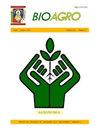Gas exchange and chlorophyll fluorescence in sugar beet leaves under water stress and ascorbic acid application
IF 0.7
4区 农林科学
Q4 AGRONOMY
引用次数: 0
Abstract
Sugar beet (Beta vulgaris L.) is one of the most cultivated vegetables in Brazil, where water limitation is the main cause of yield loss. This limitation can be attenuated with the application of organic solutes, such as ascorbic acid (AA). The objective was to evaluate the response of sugar beet plants under the application of AA via irrigation water as a strategy to attenuate water deficit. The experiment was carried out at the Centro de Ciências Agrárias of the Universidade Federal da Paraíba, Areia, Brazil, using a randomized complete block design with nine combinations of irrigation depths based on five evapotranspiration percentages (40.0, 51.6, 80.0, 108.4 and 120 % ET) and five doses of AA (0, 0.29, 1.0, 1.71 and 2.0 mM), with three replications, generated from a central composite matrix. Water use efficiency (WUE) and chlorophyll fluorescence index were evaluated. Data were submitted to analysis of variance and, when significant, to a regression analysis. Irrigation depths influenced chlorophyll a, b and total, maximum fluorescence, instantaneous WUE and intrinsic WUE, but no effect was observed for AA. The beet cultivar Maravilha Top Tall Early Wonder exhibits certain physiological mechanisms of tolerance to water stress. The ascorbic acid, in the concentrations and application method used in the study, had no effect on the beet plant response.水分胁迫下甜菜叶片的气体交换和叶绿素荧光及抗坏血酸的应用
甜菜(Beta vulgaris L.)是巴西种植最多的蔬菜之一,水分限制是造成产量损失的主要原因。这种限制可以通过应用有机溶质如抗坏血酸(AA)来减弱。目的是评估甜菜植株在灌溉水施用AA的情况下的反应,以此作为减少缺水的策略。该实验在巴西阿雷亚联邦帕拉伊巴大学的Ciências Agrárias中心进行,采用随机完全区组设计,基于五种蒸散百分比(40.0、51.6、80.0、108.4和120%ET)和五种剂量的AA(0、0.29、1.0、1.71和2.0 mM),采用九种灌溉深度组合,进行三次重复,由中央复合矩阵生成。评价了水分利用效率(WUE)和叶绿素荧光指数。将数据提交给方差分析,如果数据显著,则进行回归分析。灌溉深度对叶绿素a、b和总、最大荧光、瞬时WUE和内在WUE均有影响,但对AA无影响。研究中使用的抗坏血酸浓度和施用方法对甜菜植株的反应没有影响。
本文章由计算机程序翻译,如有差异,请以英文原文为准。
求助全文
约1分钟内获得全文
求助全文
来源期刊

Bioagro
Agricultural and Biological Sciences-General Agricultural and Biological Sciences
CiteScore
1.40
自引率
37.50%
发文量
22
期刊介绍:
Bioagro es una revista científica del Decanato de Agronomía de la Universidad Centroccidental “Lisandro Alvarado” (UCLA). Su periodicidad es cuatrimestral y se publica en los meses de enero, mayo y septiembre. Cada trabajo es revisado por al menos dos especialistas en el área, externos a la revista, de cuya opinión depende la aceptación definitiva. Se utiliza sistema de arbitraje doble ciego.
La revista va dirigida, fundamental pero no exclusivamente, a profesionales y técnicos del área agrícola. Su objetivo es publicar trabajos científicos originales e inéditos en ciencias agrícolas que enfoquen aspectos de agronomía, botánica y propagación de plantas, entomología y zoología, suelos, fitopatología y protección vegetal, ingeniería agrícola, genética y mejoramiento de plantas, ecología, procesamiento de productos agrícolas, biotecnología y sociales. También pueden ser publicados artículos cortos en los que se presenten descubrimientos científicos, desarrollos tecnológicos y resultados de diagnósticos integrales, en la modalidad de Notas Técnicas.
En Venezuela, se encuentra en las bibliotecas de todas las universidades e institutos de educación superior que ofrecen carreras agronómicas, así como de los entes oficiales de investigación agropecuaria. En el exterior, la revista llega a universidades y/o institutos de investigación agrícolas de todos los países de América Latina así como Estados Unidos, Canadá y España.
 求助内容:
求助内容: 应助结果提醒方式:
应助结果提醒方式:


